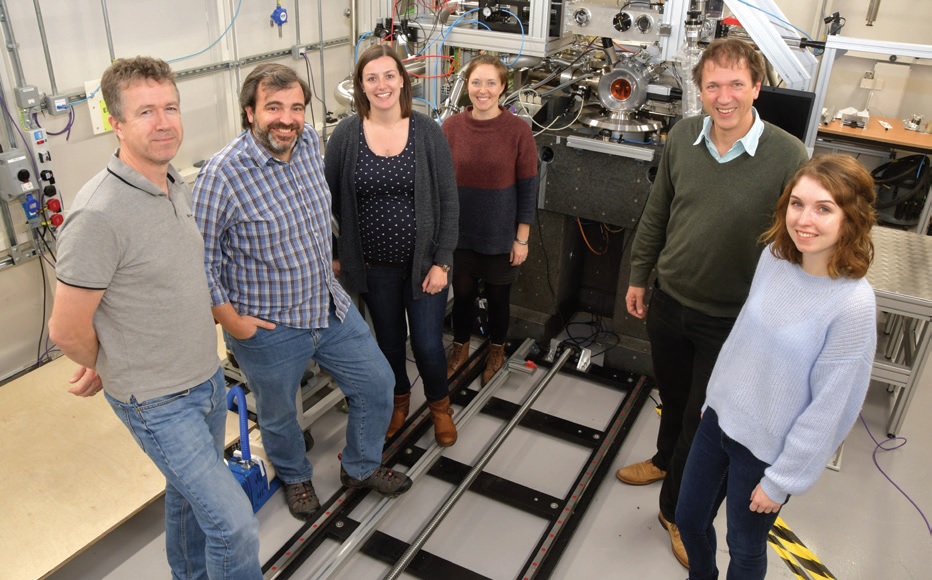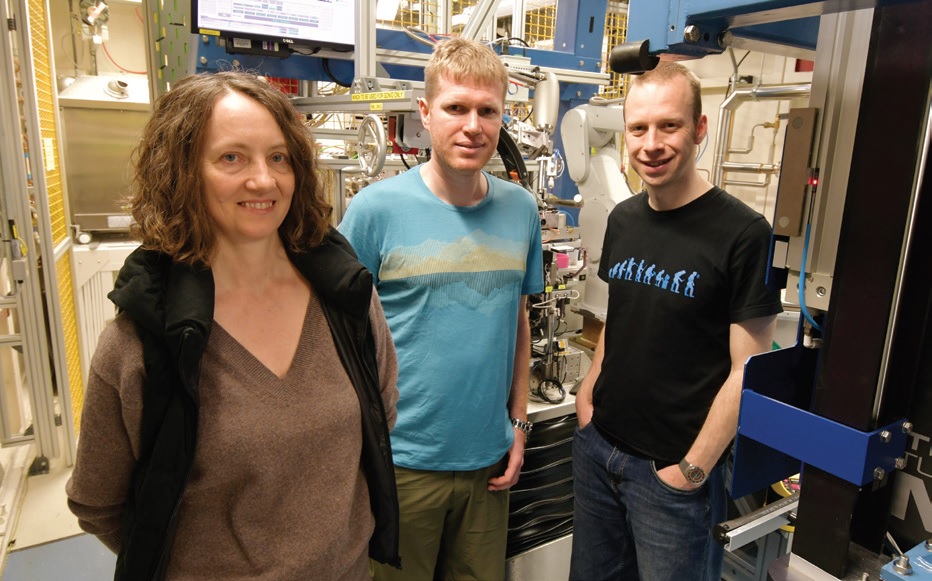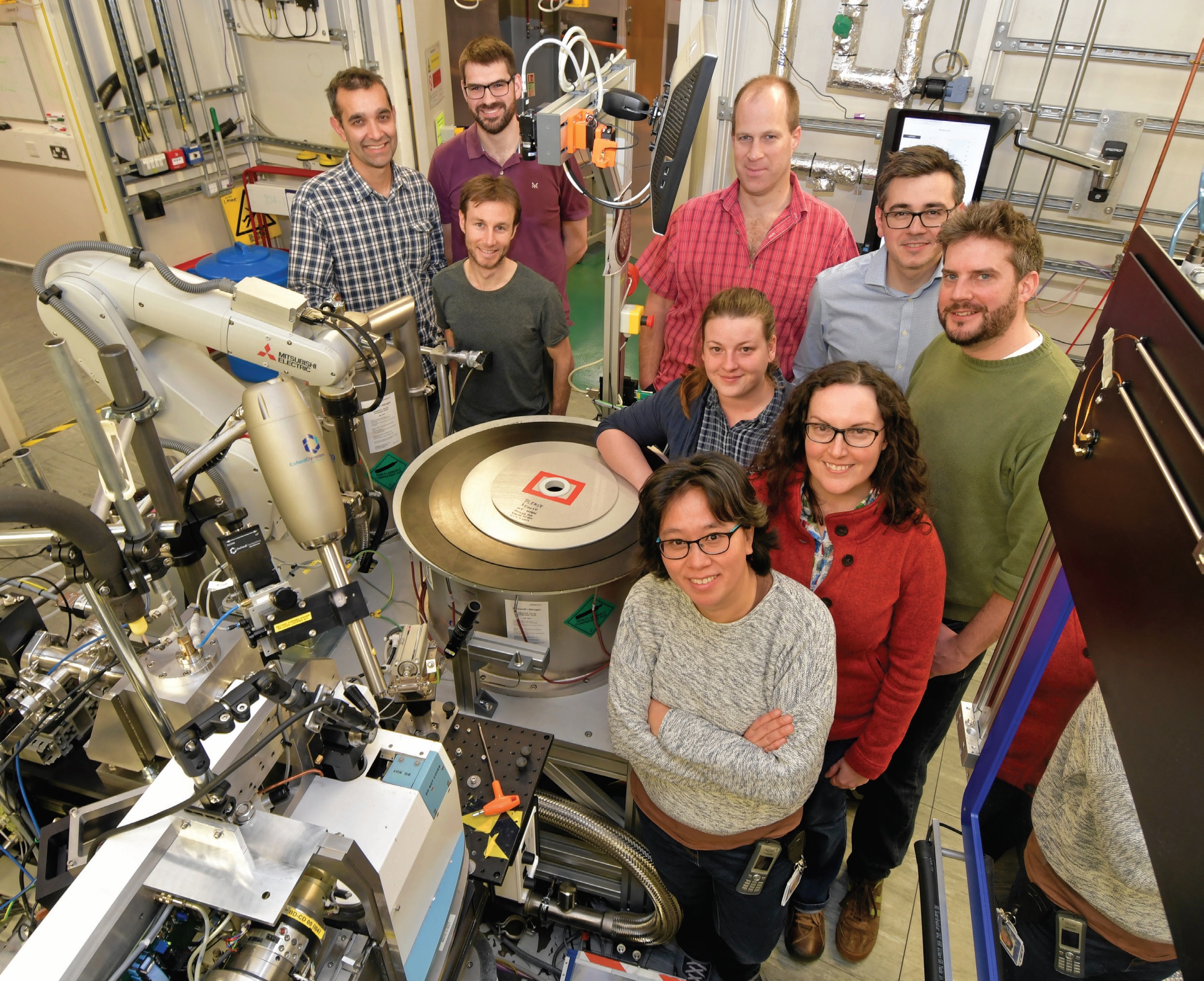Keep up to date with the latest research and developments from Diamond. Sign up for news on our scientific output, facility updates and plans for the future.

It has been an exciting year for the VMXm micro/nanofocus MX beamline. After performing the first protein diffraction experiments at room temperature and in vacuum back in May 2018, first user experiments followed in October 2018. The group of Dr Ivo Tews from University of Southampton measured data from their sample crystals mounted on cryoelectron microscopy grids held at cryogenic temperatures in the evacuated sample environment. The compact sample space incorporates an on-axis video microscope and a Scanning Electron Microscope (SEM) for sample visualisation. The SEM has already proved invaluable in identifying the location, size, and shape of micron sized crystals. The smallest X-ray beam size measured to date on VMXm is currently 0.4 x 1.2 μm, and further commissioning and optimisation will take place throughout 2019.
Beamline VMXi provides a highly intense X-ray beam for the study of crystals at room temperature, particularly in the media in which the crystals are grown. Through 2018, significant upgrades have been made that enable VMXi to progress to a full user programme, with the beamline being the test bed for the first 2nd generation Eiger2 X detector (4M), which is capable of collecting data at very fast rates with extremely high count rates - perfectly matched to room temperature data collection with a very intense X-ray source. A new sample viewing system, and improved alignment configuration, now enable accurate automatic collection of data sets from many 10s, if not 100s of crystals per hour. Early experiments with serial crystallography delivery methods have been trialled and will add a further strength to the beamline capabilities in the coming years.

Building on the work for Eiger detectors on VMXi, the first of the Eiger2 X 16M series detector model has been installed on beamline I04 recently. It replaces the first generation Pilatus2 detector, and provides a significant number of advantages and improvements that are benefitting the user community and science output. Data acquisition rates have increased five-fold over the previous detector, and a typical data set can now be collected in less than 15 seconds. The Eiger2 detector’s much smaller pixel size, coupled with no read-out time and vastly increased count rate capability, is leading to high dynamic range data with reduced background noise, improving data quality, and is beneficial in resolving large unit cells. Recently we installed the second Eiger2 X 16M detector on beamline I03 to complement the MX beamline suite’s capabilities.
Remote data collections are routine on the cryo-MX beamlines at Diamond and, over the last few years, there has been a steady increase in the numbers of samples shipped to Diamond for remote sessions, with more recently up to 90 dewars (or 10,000 sample mounts) on-site at any one time. Consequently, the logistics of managing users’ dewars and pucks has become more complicated, requiring new systems for tracking and streamlining the process of setting up for remote experiments. Tracking has been resolved by barcoding pucks and shipping dewars, and utilising the experiment database ISPyB. In this way, every experiment is tracked, and the responsible Diamond scientist is automatically informed which dewars are needed and where they are. The puck barcodes are scanned as they are loaded into the robot storage dewar and, consequently, the user is presented with a list of their samples when they start the data acquisition software. All these tools will be essential over the next few months as sample throughput is likely to increase further following the installation of new, faster detectors and, when automated, queued data collections become more widely used.
In the push to increase throughput across the beamlines, upgrades and methods are continuously being rolled out across the facilities.

Automated collection of data on beamline I04-1 has underlined the success of the crystal-based fragment screening facility, XChem, which to date has supported more than 130 new screens from academia and industry for fragment-based drug discovery. In October 2018, the I04-1/XChem team hit the milestone of the 100,000th XChem crystal collection – just three and half years since the XChem programme started. To meet the MX user’s increasing demands for XChem, the platform has been expanded, and a dedicated XChem support team has been put in place. More information on the XChem facility can be found in the Integrated Facilities section.
Diamond Light Source is the UK's national synchrotron science facility, located at the Harwell Science and Innovation Campus in Oxfordshire.
Copyright © 2022 Diamond Light Source
Diamond Light Source Ltd
Diamond House
Harwell Science & Innovation Campus
Didcot
Oxfordshire
OX11 0DE
Diamond Light Source® and the Diamond logo are registered trademarks of Diamond Light Source Ltd
Registered in England and Wales at Diamond House, Harwell Science and Innovation Campus, Didcot, Oxfordshire, OX11 0DE, United Kingdom. Company number: 4375679. VAT number: 287 461 957. Economic Operators Registration and Identification (EORI) number: GB287461957003.